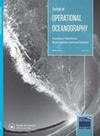X-band radar as a tool for monitoring natural coastal behaviour and potential development impacts
IF 2.4
3区 地球科学
Q4 METEOROLOGY & ATMOSPHERIC SCIENCES
引用次数: 1
Abstract
ABSTRACT This paper reports ongoing exploration of X-band radar as an operational monitoring tool for coastal infrastructure development. Data have been continually gathered since 2013, helping a major energy developer (EDF Energy) better understand shoreline processes at a proposed new nuclear power station at Sizewell, UK, to inform considerations of engineering design. The continual coverage provided by the radar enables greater confidence in defining natural variability and therefore enhanced assurance to regulators of the integrity or suitability of the site. Sizewell is located on a low-lying, soft coast with at least 1000 years of recorded (net) retreat. The commercial X-band system deployed calculates hydrodynamic data (suitable for managing navigation and vessel access), but this paper illustrates using radar images to establish the pre-construction baseline geomorphic behaviour of the nearshore, including a steep pebbly beach-face, two shore-parallel sub-tidal sandbars, and a large sandbank, 2 km offshore, which significantly affects nearshore hydrodynamics. Data illustrate baseline geomorphic behaviours that were previously unobserved, despite beach profiling records over 20 years. The temporal and spatial scales of natural changes are compared with the potential impacts of the development, including dredging (and spoil deposition) for navigation channel maintenance and the presence of nearshore structures, all of which would affect shoreline processes and so would need to be monitored (and any impacts managed) as development proceeds. Finally, the paper considers where the utility of X-band radar as an operational monitoring tool may surmount the barriers that have limited its uptake outside of academic/research circles.x波段雷达作为监测海岸自然行为和潜在发展影响的工具
本文报道了正在进行的x波段雷达作为沿海基础设施发展的操作监测工具的探索。自2013年以来,数据一直在不断收集,帮助主要能源开发商(EDF energy)更好地了解英国Sizewell拟议中的新核电站的海岸线过程,为工程设计提供参考。雷达提供的持续覆盖使人们更有信心确定自然变化,从而增强了对场地完整性或适宜性的监管保证。Sizewell位于一个低洼、柔软的海岸上,至少有1000年的撤退记录。部署的商用x波段系统计算水动力数据(适用于管理导航和船舶访问),但本文说明了使用雷达图像来建立近岸的施工前基线地貌行为,包括陡峭的卵石海滩面,两个海岸平行的潮汐下沙洲,以及离岸2公里的大型沙洲,这对近岸的水动力有重大影响。尽管有20多年的海滩剖面记录,但数据显示了以前未被观察到的基线地貌行为。将自然变化的时间和空间尺度与开发的潜在影响进行比较,包括疏浚(和废土沉积)以维护航道和近岸结构的存在,所有这些都会影响海岸线的过程,因此需要在开发过程中进行监测(并管理任何影响)。最后,本文考虑了x波段雷达作为一种作战监测工具在哪些方面可以克服限制其在学术/研究界以外应用的障碍。
本文章由计算机程序翻译,如有差异,请以英文原文为准。
求助全文
约1分钟内获得全文
求助全文
来源期刊
CiteScore
7.50
自引率
9.70%
发文量
8
审稿时长
>12 weeks
期刊介绍:
The Journal of Operational Oceanography will publish papers which examine the role of oceanography in contributing to the fields of: Numerical Weather Prediction; Development of Climatologies; Implications of Ocean Change; Ocean and Climate Forecasting; Ocean Observing Technologies; Eutrophication; Climate Assessment; Shoreline Change; Marine and Sea State Prediction; Model Development and Validation; Coastal Flooding; Reducing Public Health Risks; Short-Range Ocean Forecasting; Forces on Structures; Ocean Policy; Protecting and Restoring Ecosystem health; Controlling and Mitigating Natural Hazards; Safe and Efficient Marine Operations

 求助内容:
求助内容: 应助结果提醒方式:
应助结果提醒方式:


